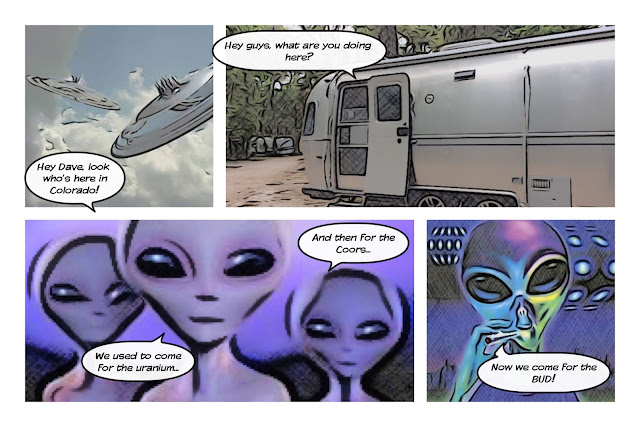 |
| In the Black Canyon, 48 miles of the Gunnison River drop an average of 34 ft per mile & at Chasm View, drop 240 ft in one mile. |
In our travels we’ve seen
lots of canyons. Canyons of all shapes and sizes, but none combine the depth,
sheerness, narrowness, darkness, and foreboding of the Black Canyon of the Gunnison River. Native Americans avoided
it. The Utes dubbed it “Much rocks, big water” but stayed out. Europeans eventually conquered it in 1882
with a railroad route through the canyon, but it was costly & difficult to
operate and eventually abandoned in 1955.
Today the river is somewhat
tamed by the dams up river, but still treacherous. The bottom of the canyon is accessible, but
only to the eager, willing and proficient. Expert kayakers must be prepared to
drag their gear around dangerous and impassable stretches of the river to experience
the thrill of class III-V rapids.
Advanced rock climbers can scale the sheer cliffs of the inner canyon or
hikers can spend 2 hours scrambling down unmaintained draws and 4 hours
crawling back up. As if rapids, cliffs, and steep draws (one aptly named S.O.B)
aren’t a deterrent; poison ivy grows abundantly in the draws and along the
canyon floor, ticks lay in wait in the gulches ready to pounce and afternoon
thundershowers can make for a bad hair day.
 |
| The Painted Wall at 2,250 ft is the tallest cliff in Colorado Do you see the Dragon? |
Fortunately for those of us
not willing to drag a kayak, rappel down a cliff or crawl through poison ivy
beating off ticks, there are paved roads and hiking trails along the north and
south rim, (so we can at least look down with that flutter in the stomach) and
one set of 16% switchbacks to the river at the eastern end of the canyon.
The National Park has 3
campgrounds: the South Rim provides electricity for tents & RVs, the North
Rim has dry camping for tents & RVs and the East Portal along the river, is
limited to tents and tiny trailers (max total vehicle & trailer length of
22 ft.) We opt to stay near the north
rim in the Iron Creek campground of Crawford State Park. We have water, electricity, great views of
the rolling hills, the reservoir and a small herd of deer who visit every
morning and evening.
 |
| With full sun for 33 min/day timing is everything. |
Black Canyon Road, near
Crawford is the only access to the north rim.
There’s a small ranger station but no visitor center. The Chasm View Nature Trail starts near the
campground and leads to a number of vista points, where we can view 2,000+ ft.
sheer cliffs and look straight down to the canyon floor, safely behind heavy
guard rails. The North Vista Trail
starts near the ranger station. After crossing the mesa, the trail winds along
the canyon rim. There are spur trails
that take us right to the edge. No
civilized barriers here… just slick rock and sheer cliffs… down… down…
down. At the three-mile mark, we stop at
Exclamation Point. Here we have a strait
view of the river through the canyon.
The cliffs are so steep that the river is in full sun for only 33
minutes a day… and we hit it pretty close to this window.
 |
| Exclamation Point Top of the Painted Wall No Guard Rails Here… and it's 2,250 ft straight down! |
The south rim is the
civilized rim. We start at the visitor
center and catch a short film about the Canyon.
Then it’s a cruise along the South Rim Drive with stops at all of the
turnouts. Some of the views are right
off the road, while others have a short hike to the viewpoint. Every view is breathtaking.
 |
| Gunnison River below Crystal Reservoir Dam hard to believe this turns into class V rapids... |
The East Portal Road is the
only access to the river. It’s paved
with a series of 16% grade switchbacks.
At the bottom of the road, the Gunnison diversion dam feeds the GunnisonTunnel. This 5.8 mile engineering marvel
diverts water from the Gunnison, through the mountain, to the arid Uncompahgre
Valley near Montrose. The road ends at
the Crystal Reservoir Dam (no public access to the reservoir here.) The river
is flowing and from the number of anglers present we assume that this must be a
good spot for fly-fishing although no fish were harmed during our visit.
Besides great scenery, for
driving and hiking around the canyon there are numerous roadside fruit &
vegetable stands, selling local organic goods… Our Colorado favorites: Olathe
Sweet corn and Palisade Peaches are still on the menu… YUM!































